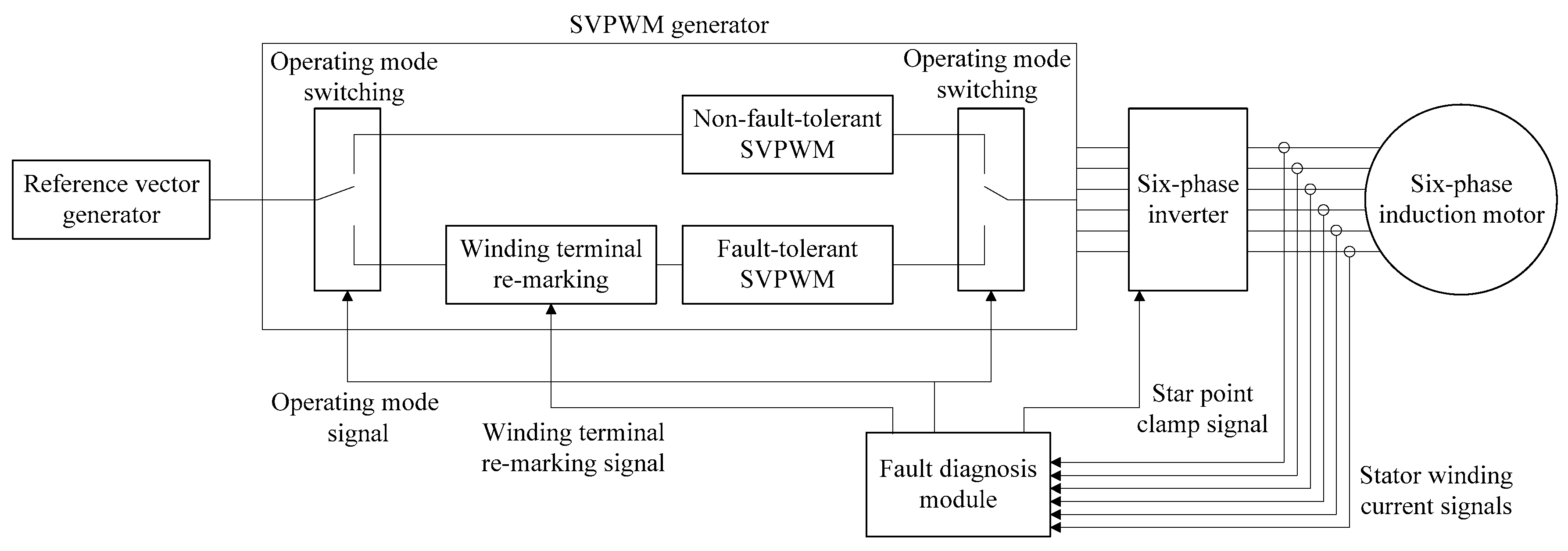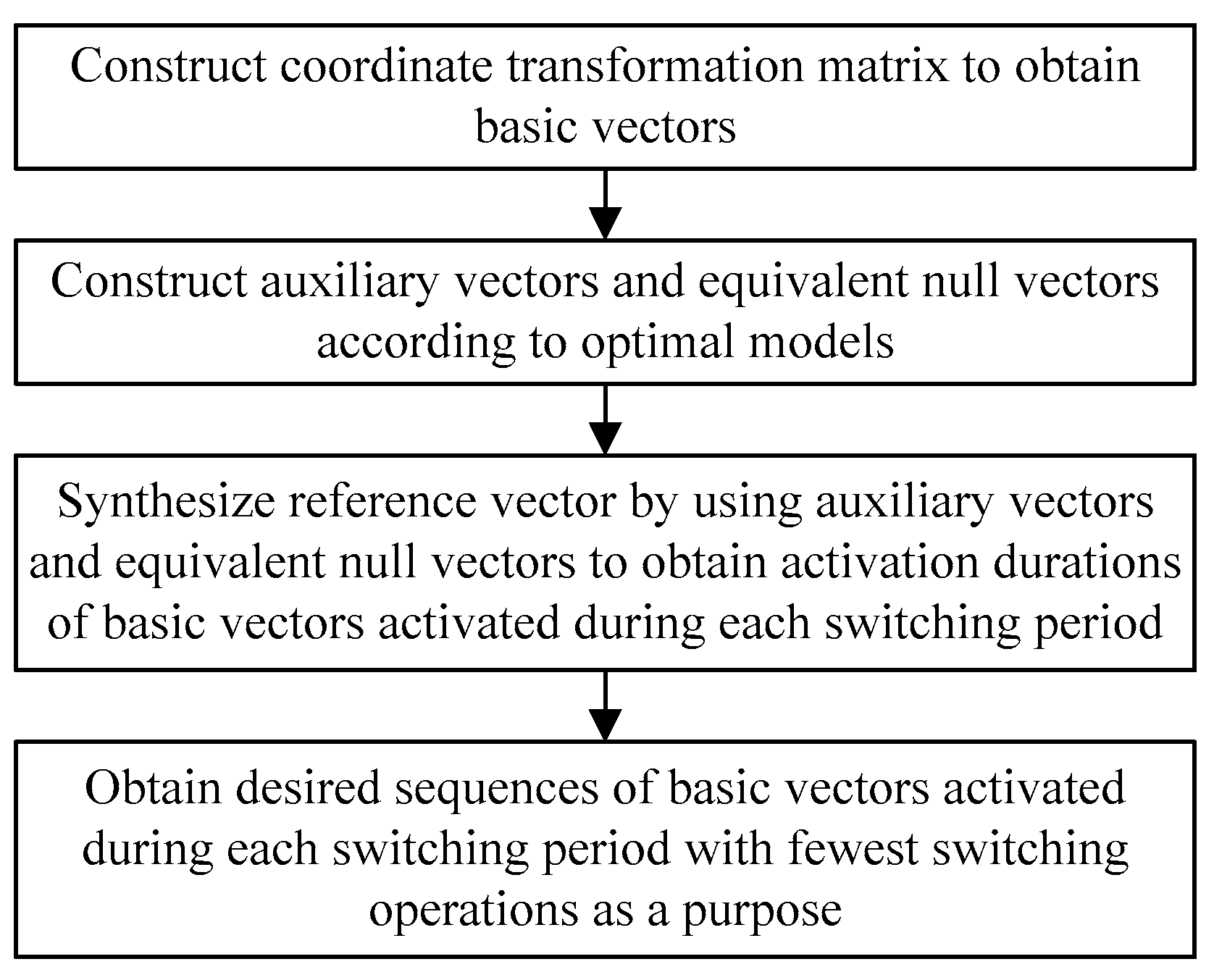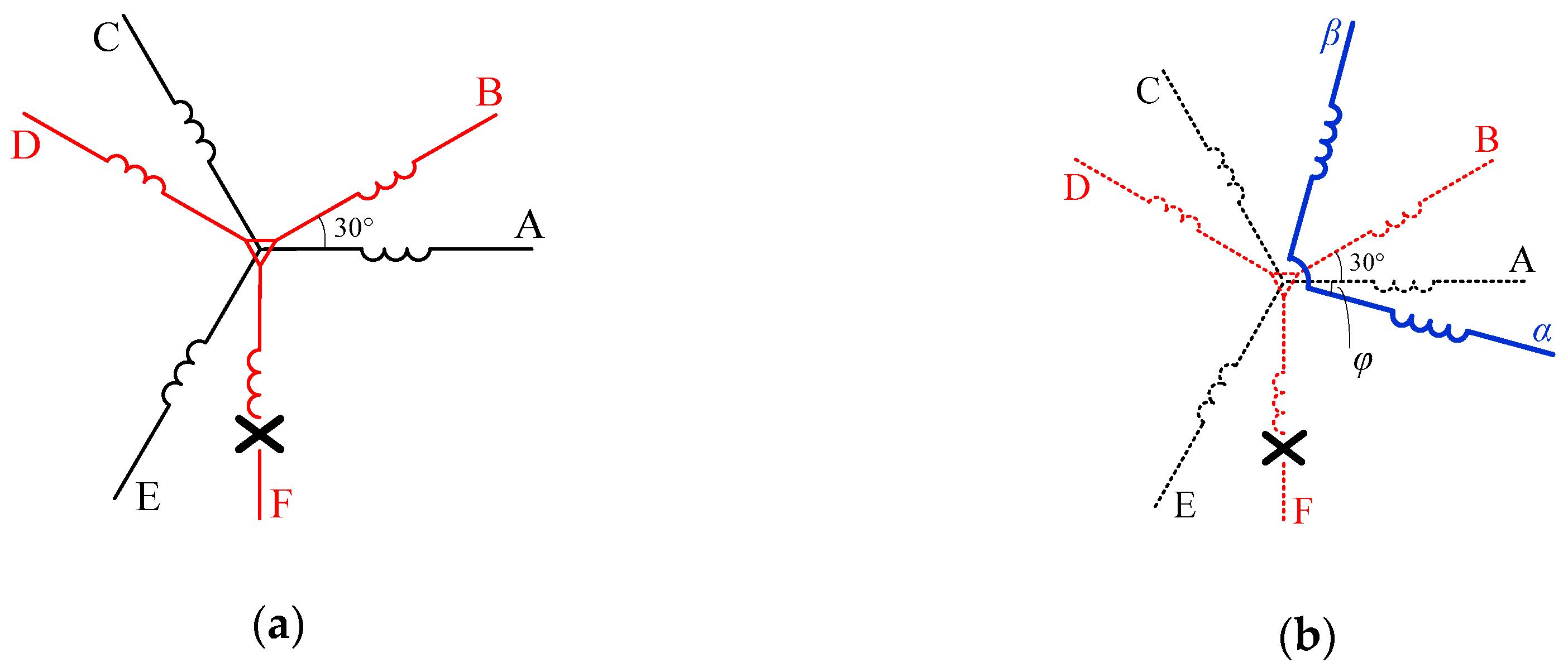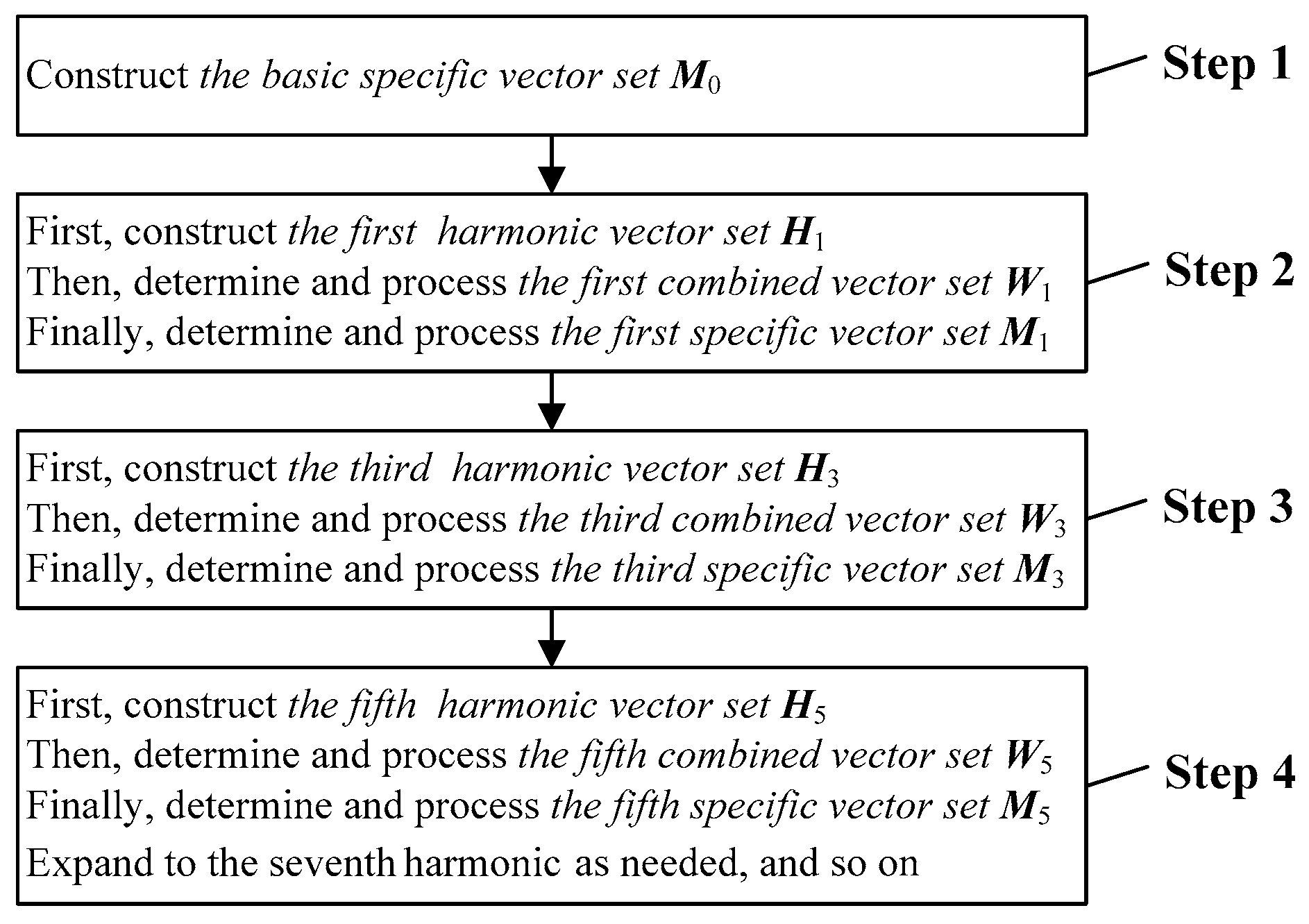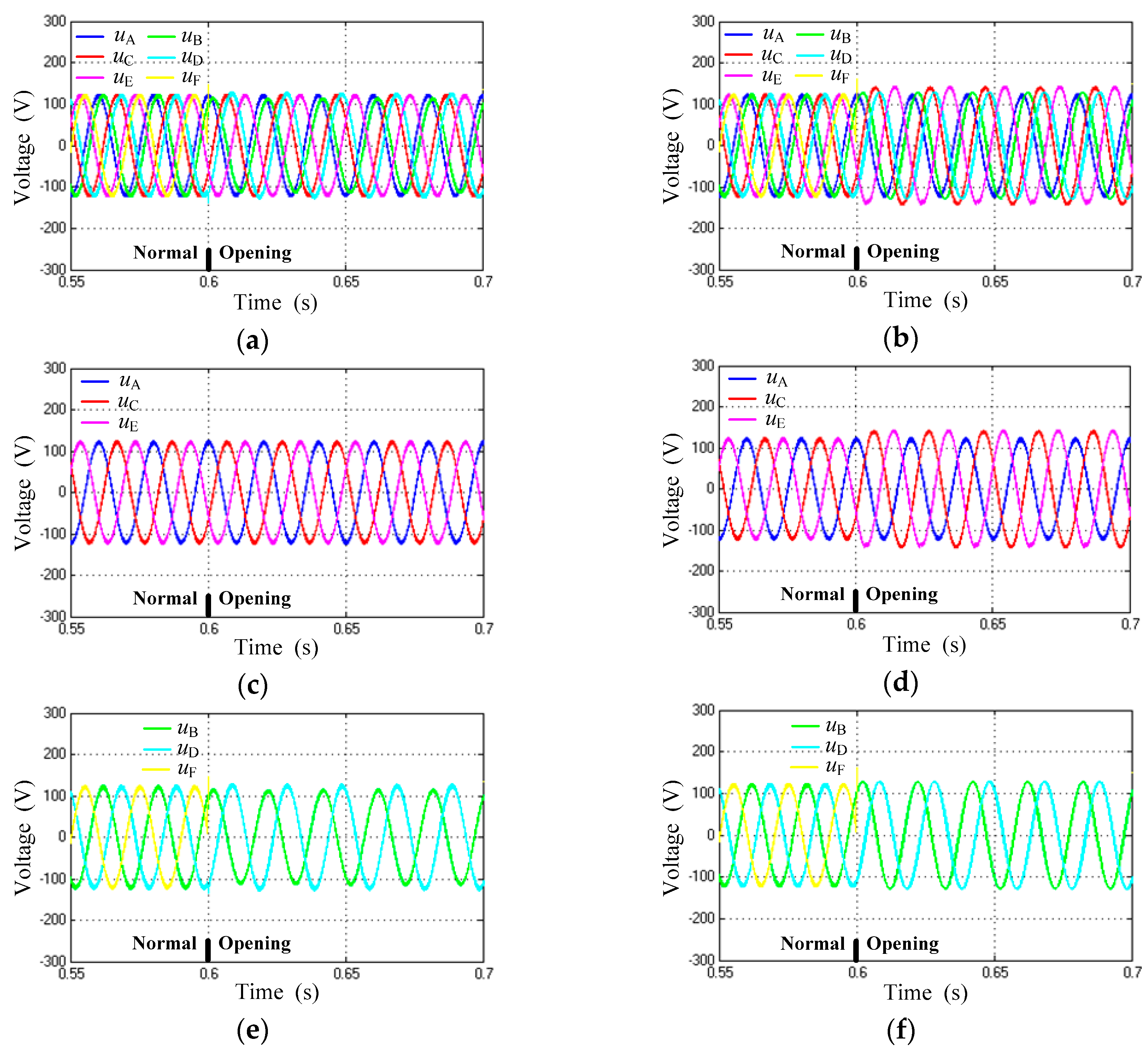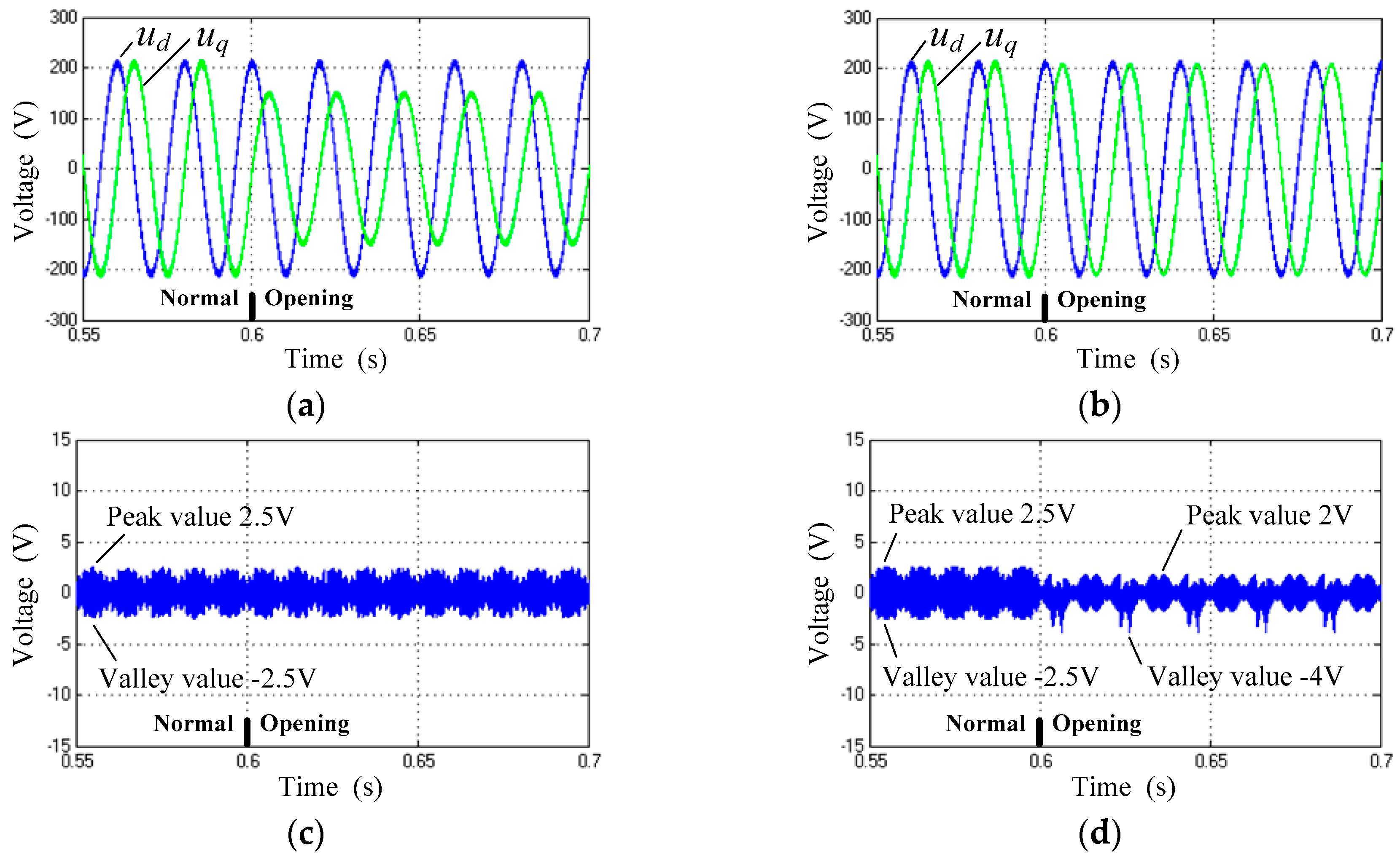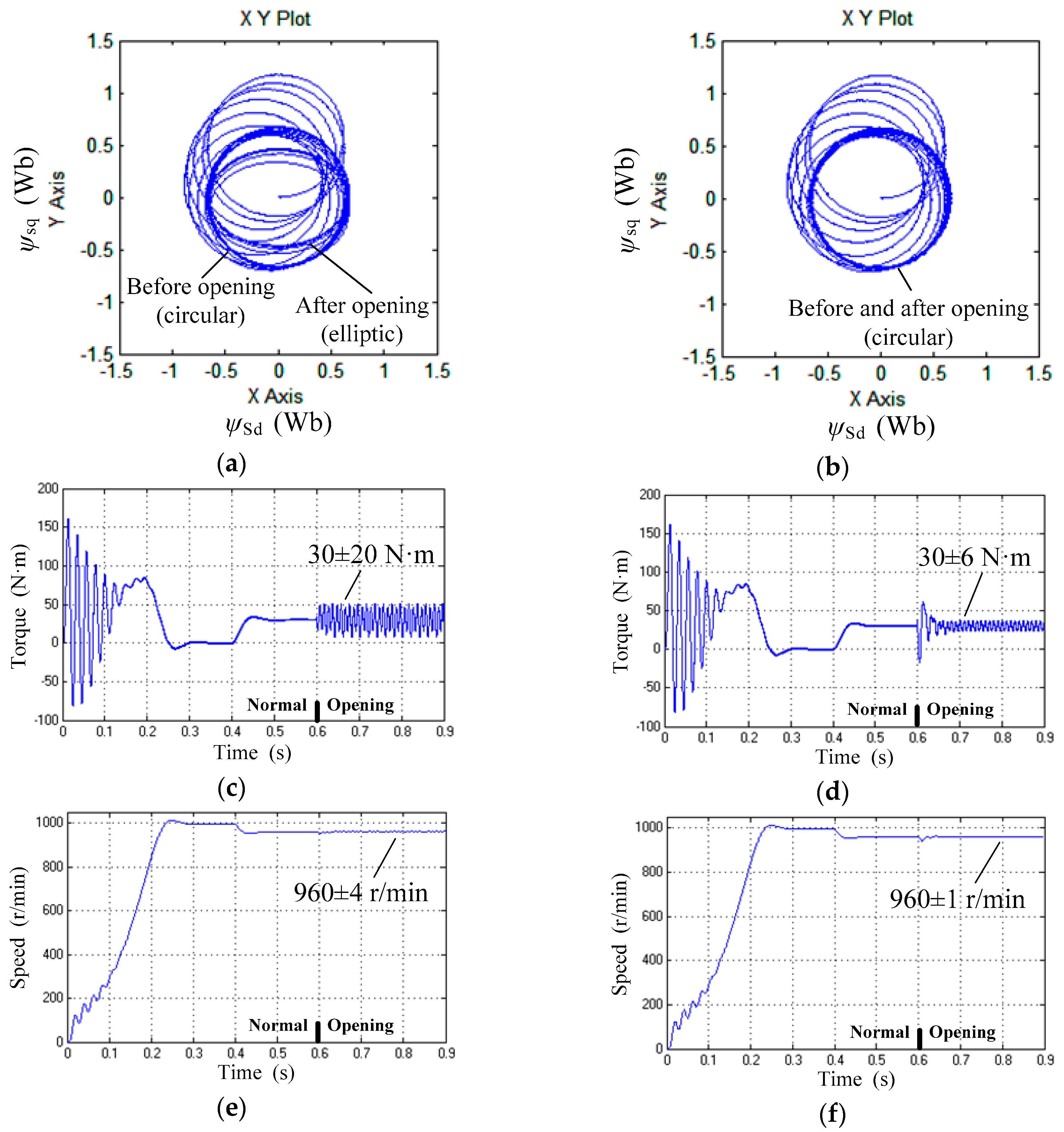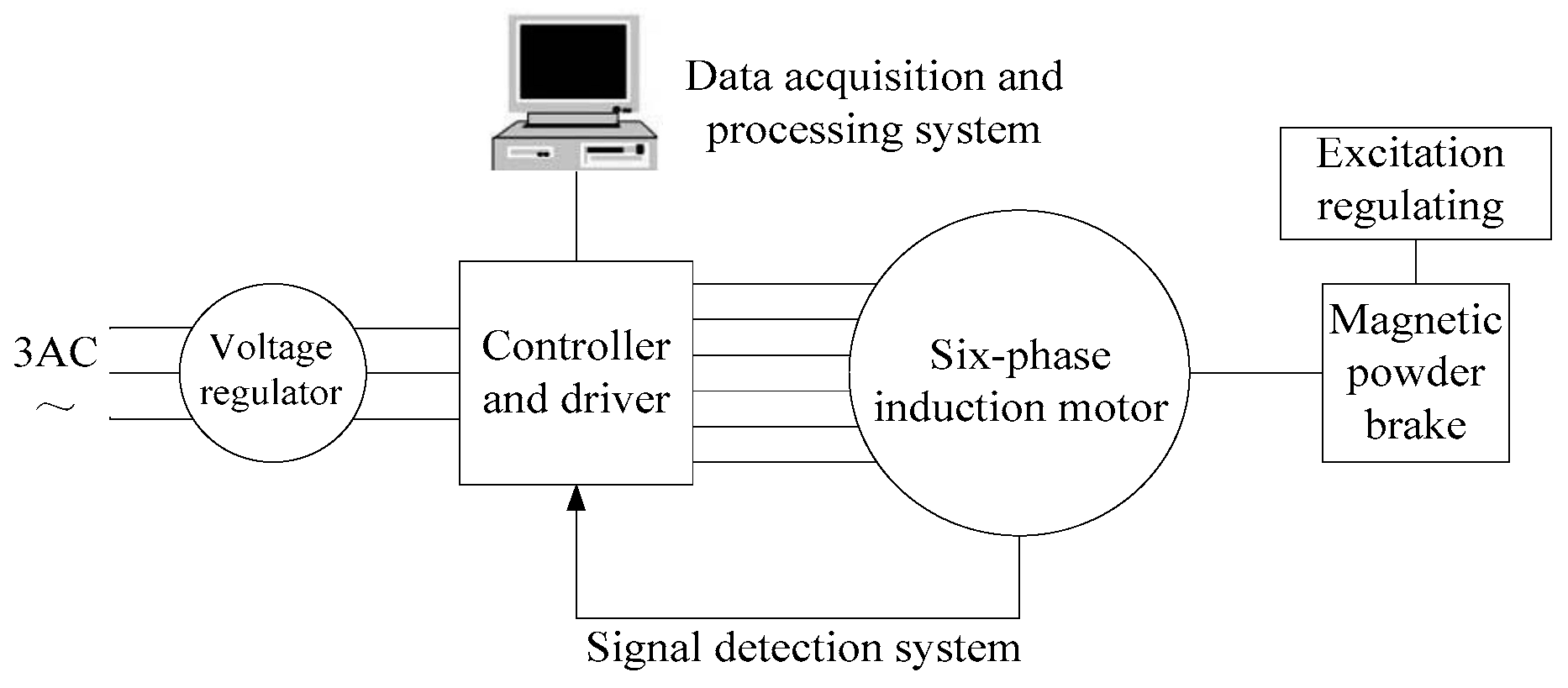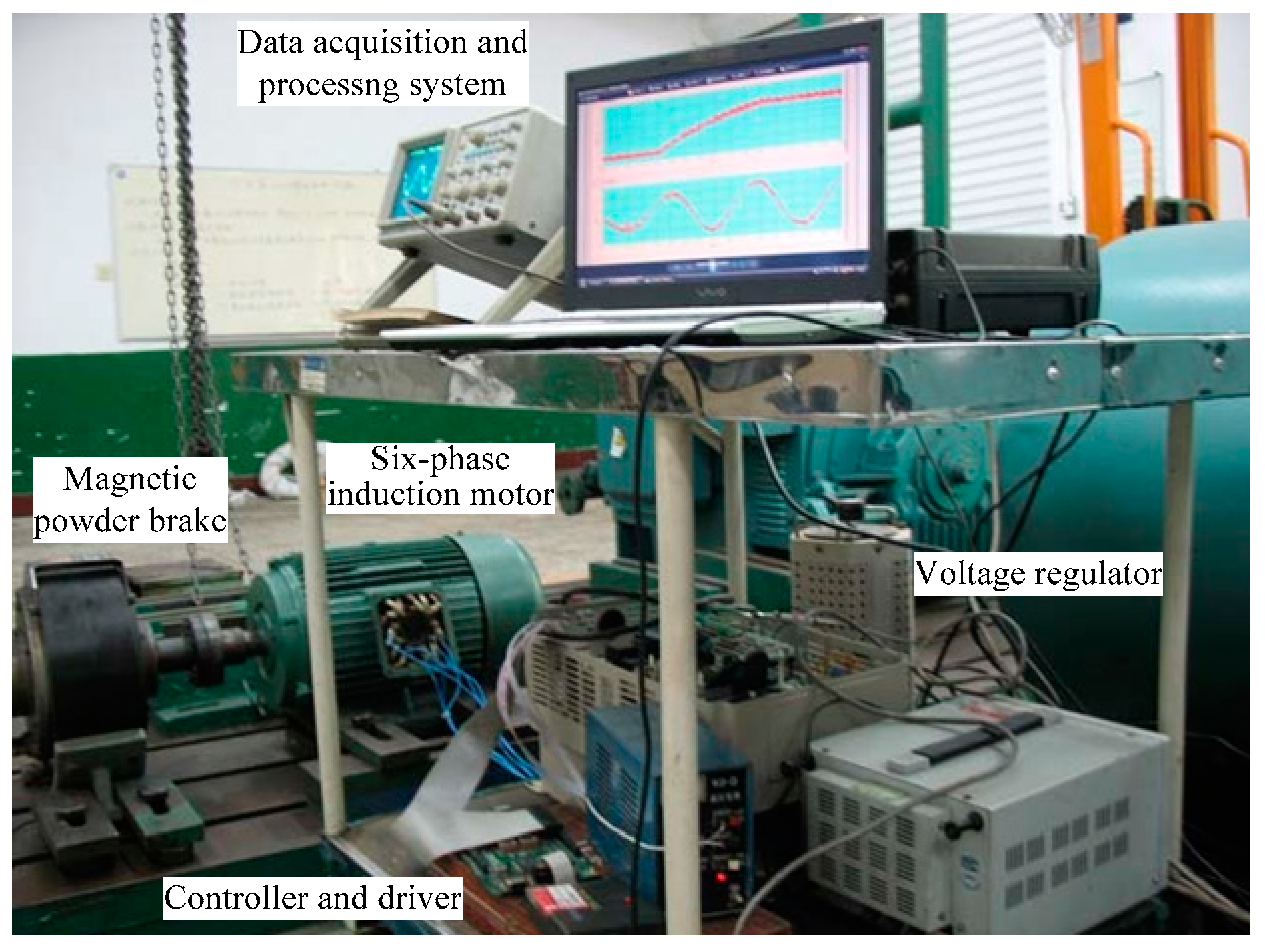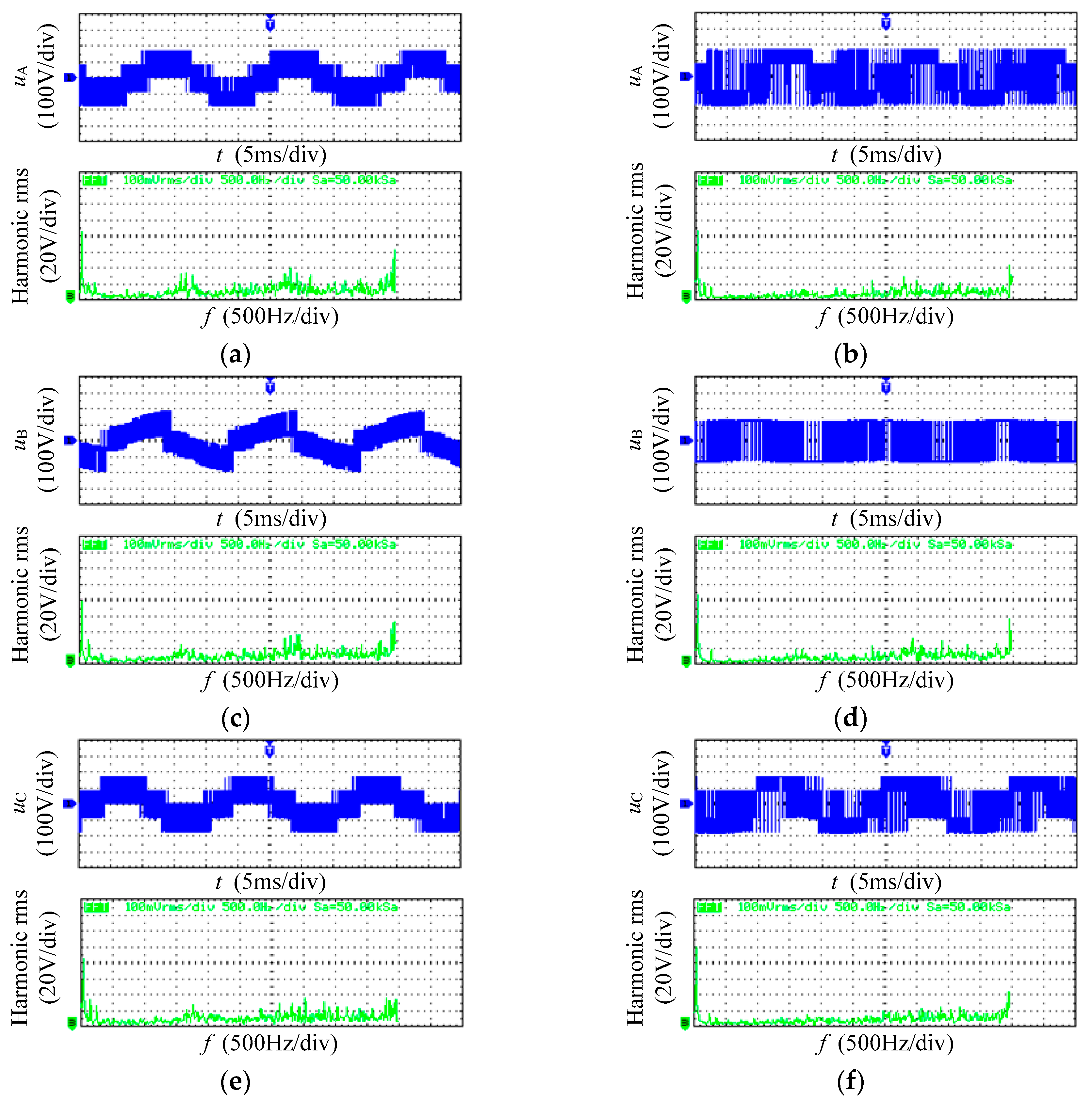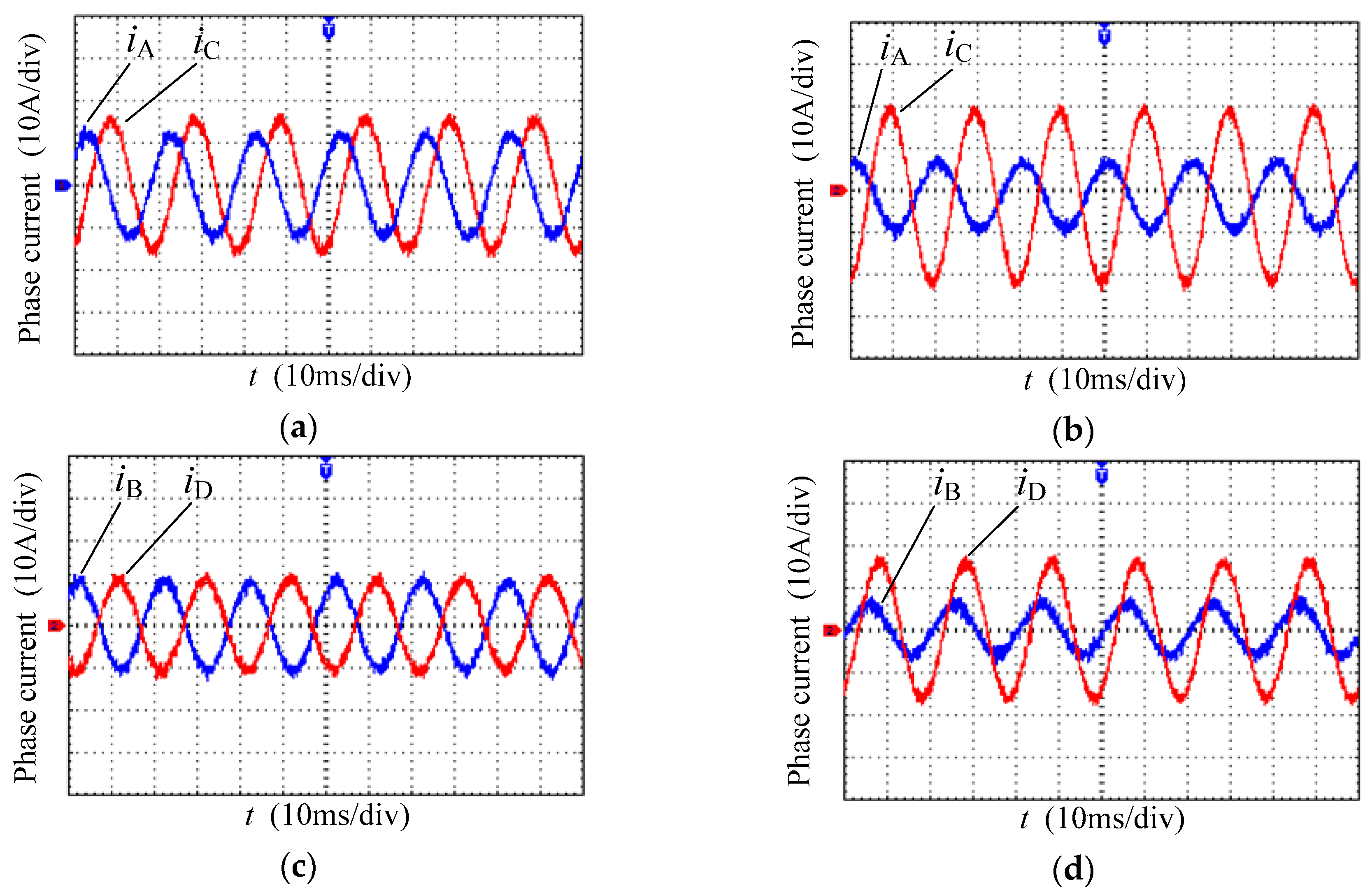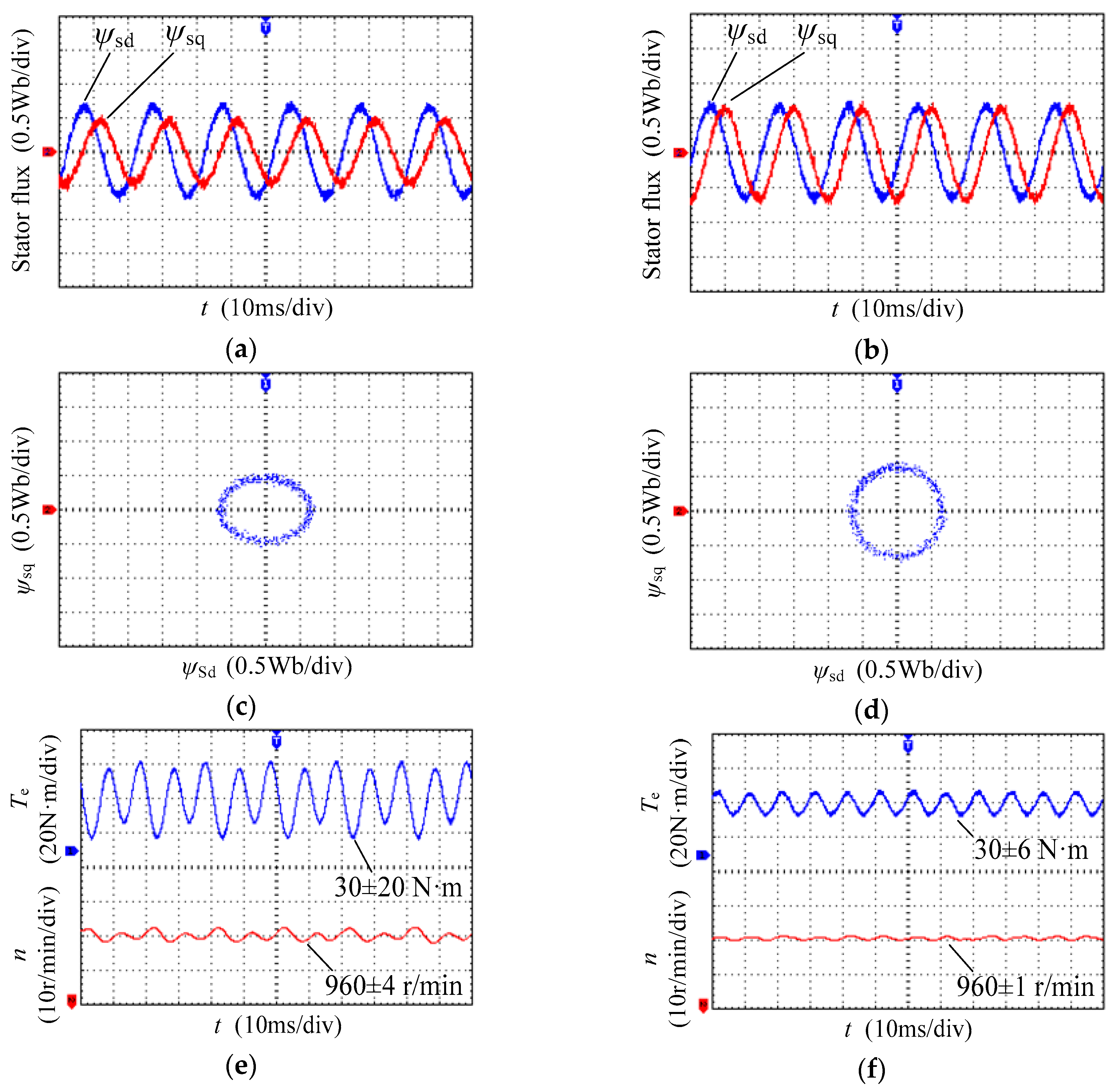2.1. Overall Design
The schematic diagram of control structure is shown in
Figure 2, where there are three main modules: a reference vector generator, an SVPWM generator, and a fault diagnosis module. The SVPWM generator has four function frames: the operating mode switching, the non-fault-tolerant SVPWM, the winding terminal re-marking, and the fault-tolerant SVPWM.
The fault diagnosis module can determine whether the six current signals of the stator winding are zero, and output three control signals: an operating mode signal, a winding terminal re-marking signal, and a star point clamp signal. The operating mode signal can control the switching of two operating modes. In this paper, simulation 1 and experiment 1 use the non-fault-tolerant SVPWM under both the normal condition and fault condition, while simulation 2 and experiment 2 use the non-fault-tolerant SVPWM under the normal condition, and use the fault-tolerant SVPWM under the fault condition. Before running the fault-tolerant SVPWM, it is necessary to remark the winding terminals, that is, to renumber the physical quantities of six windings. As shown in
Figure 3, the letters in parentheses are the winding number after failures. It is known from
Figure 3 that no matter which phase winding is open-circuited, it can be equivalent to the F-phase failure.
Without loss of generality and assuming that the F-phase winding is open-circuited, the current through the F-phase winding becomes zero, whereas the voltage across the F-phase winding is not zero because the induced voltage remains, which cannot be directly controlled. To control the B-phase and D-phase winding voltages, while fully using the B-phase and D-phase windings, the voltage clamp for star point
n is made. As shown in
Figure 1b, a triode AC switch (TRIAC) is connected between star pint
n and centre point
g of the inverter DC voltage, which is switched on by the star point clamp signal from the fault diagnosis module. When the F-phase winding becomes open-circuited, the TRIAC is switched on, star point
n is connected to centre point
g, and the potential of star point
n is clamped.
On the basis of the above design, we will focus on the design and implementation of the fault-tolerant SVPWM in
Figure 2. The research route is shown in
Figure 4.
2.2. Coordinate Transformation Matrix
After the F-phase winding becomes open-circuited, the stator winding can be considered an asymmetric five-phase winding, the physical model of which is shown in
Figure 5a. On the basis of the dynamic mathematical model of the six-phase motor, the physical quantities related to the F-phase winding are deleted, and the F-phase-deficient dynamic mathematical model of the six- phase motor is obtained. The model requires a five-dimensional matrix to perform the coordinate transformation. The matrix should follow the equivalent principle of equal magnetic motive force and equal power before and after the transformation. The matrix that satisfies the principle is not unique; therefore, the equivalent models of the motor obtained using different matrices are identical.
In this paper, a scheme of matrix construction is proposed, where the current constraint condition of the remaining healthy phase windings is considered in addition to the equivalent principle above. Therefore, the scheme can reduce the order of the differential equation of the motor, and be extended to arbitrary-phases open-circuit fault of multiphase machines. The detailed steps are performed according to the flow chart in
Figure 6.
Step 1: Construct the basic specific vector set
M0:
m01,
m02, … according to the current constraint condition of the remaining healthy phase windings. The number of vectors in
M0 is equal to the number of current constraint conditions. Because the current constraint conditions are independent of one another,
M0 is linearly independent. With the circuit configuration in
Figure 1b, there is one current constraint condition:
iA +
iC +
iE = 0; thus, one vector
m01 is obtained.
Step 2: First, construct the first harmonic vector set
H1:
h11,
h12 according to the equivalent principle of equal first magnetic motive forces before and after the transformation.
H1 has two vectors:
h11 and
h12. For the circuit configuration in
Figure 1b, establish the two-phase station reference frame (
α-
β) on the physical model diagram of the stator windings; the angle between the
α-axis and the A-axis is
ϕ, as shown in
Figure 5b, and there is
Vectors
h11 and
h12 must satisfy
h11Th12 = 0; thus,
ϕ = 0 can be determined. Substituting
ϕ = 0 into (2) gives
Then, combining the basic specific vector set M0 and first harmonic vector set H1 yields the first combined vector set W1. Furthermore, determine whether W1 is linearly independent. If yes, the first specific vector set M1 is obtained, which is equal to W1; if no, any one vector in M0 can be deleted from W1; then, determine whether the processed W1 is linearly independent. Here, W1 is linearly independent, so M1 = W1.
Finally, determine whether the rank of the first specific vector set M1 is equal to the number of remaining healthy phase windings. If yes, transforming M1 into an orthonormal vector set by Gram-Schmidt orthogonalization gives the desired coordinate transformation matrix; if no, proceed to the next step. Here, the rank of M1 is 3, whereas the number of remaining healthy phase windings is 5, so we proceed to the next step.
Step 3: First, construct the third harmonic vector set
H3:
h31,
h32 according to the equivalent principle of equal third magnetic motive forces before and after the transformation.
H3 has two vectors:
h31,
h32.
Substituting
ϕ = 0 into (4) gives
Then, combining the first specific vector set M1 and third harmonic vector set H3 yields the third combined vector set W3. Furthermore, determine whether W3 is linearly independent. If yes, the third specific vector set M3 is obtained, which is equal to W3; if no, any one vector in H3 can be deleted from W3; then, determine whether the processed W3 is linearly independent. Here, W3 is not linearly independent because h31 = m01. We delete h31 from W3 to make the processed W3 become linearly independent. Thus, M3 is equal to the processed W3, which contains m01, h11, h12, and h32.
Finally, determine whether the rank of the third specific vector set M3 is equal to the number of remaining healthy phase windings. If yes, transforming M3 into an orthonormal vector set yields the desired coordinate transformation matrix; if no, proceed to the next step. Here, the rank of M3 is 4, whereas the number of remaining healthy phase windings is 5, so we proceed to the next step.
Step 4: Similar to Step 3, first construct the fifth harmonic vector set, then determine and process the fifth combined vector set, finally determine and process the fifth specific vector set. If the rank of the fifth specific vector set remains unequal to the number of remaining healthy phase windings, we continue to expand to the seventh harmonic, and so on.
Here, the extension to the fifth harmonic is performed, and the specific process is no longer detailed. The fifth specific vector set
M5 contains
m01,
h11,
h12,
h32, and
h51. The rank of
M5 is 5, which is equal to the number of remaining health phase windings. Therefore, transforming
M5 into an orthonormal vector set by Gram-Schmidt orthogonalization gives the desired coordinate transformation matrix
T5×5 as follows.
where
dT,
qT,
z1T,
z2T, and
z3T correspond to
h11T,
h12T,
h32T,
h51T, and
m01T, respectively. For convenience, the two-dimensional space generated by
dT and
qT is the
d-
q plane, the two-dimensional space generated by
z1T and
z2T is the
z1-
z2 plane, and the one-dimensional space generated by
z3T is the
z3 axis.
Using (6), we perform a coordinate transformation to the F-phase-deficient dynamic mathematical model of the six-phase motor, and the stator voltage equation is as follows
where
usd,
usq,
usz1,
usz2, and
usz3 are the equivalent voltages of the remaining healthy stator phase winding voltages
uA,
uB,
uC,
uD, and
uE after the coordinate transformation. Similarly,
isd,
isq,
isz1,
isz2, and
isz3 are the stator equivalent currents;
ird and
irq are the rotor equivalent currents;
Lsd,
Lsq,
Lmd, and
Lmq are the equivalent inductance. In addition,
Rs is the stator resistance,
Lls is the stator leakage inductance, and
p is the differential operator.
Equation (7) implies that the stator variables in the d-q plane are related to the rotor variables, while the stator variables in the z1-z2 plane and z3 axis are not. Therefore, from the electromechanical energy conversion perspective, the electromechanical energy conversion occurs only in the d-q plane and does not occur in the z1-z2 plane and z3 axis. The harmonics and losses can occur in the z1-z2 plane. The dimension of the vector space can be reduced from 5 to 4 because both voltage and current in the z3 axis are zero.
The above analysis shows that the SVPWM technique can be used if the circuit configuration in
Figure 1b and coordinate transformation matrix (6) are used under stator one-phase open-circuit fault condition. The reference voltage vector
Vref in the
d-
q plane is synthesized; in the
z1-
z2 plane, a smaller magnitude of
Vref is better and a zero magnitude of
Vref is the best to suppress the harmonic voltages of the stator.
2.3. Construction of Auxiliary Vectors
To improve the DCbus voltage utilization, the on-off states of the upper and lower switches in an inverter leg are complementary. Thus, there are 26 = 64 switching states in the six-phase two-level inverter. The 64 switching states correspond to 64 winding phase voltages, which can be represented by 64 column matrices. In the non-fault-tolerant SVPWM, the 64 column matrices are mapped to three decoupling planes by using a six-dimensional orthogonal matrix, and 64 basic voltage vectors are obtained as V0–V63. Here the subscripts 0–63 are decimal numbers, and the binary numbers corresponding to these decimal numbers represent the switching states of the inverter.
After the F-phase winding becomes open-circuited, the F-phase leg become inoperative to the motor, and the 64 switching states reduce to 2
5 = 32. In this case, the winding voltages
uA,
uC, and
uE can take five values: −2U
d/3 (U
d is the DC bus voltage), U
d/3, 0, U
d/3, and 2U
d/3; the winding voltages
uB and
uD can take two values: −U
d/2 and U
d/2. The 32 winding voltage column matrices corresponding to 32 switching states postmultiply (6); then, 32 basic voltage vectors in the
d-
q plane and
z1-
z2 plane are obtained, as shown in
Figure 7. For the comparison with the non-fault-tolerant SVPWM, in this paper, these vectors are written as
V0–
V63. Thus, each even number in the subscripts 0–63 and its neighboring odd number represent one basic vector. Hereafter, the even numbers are used.
To suppress the stator harmonic voltages, in this paper, by using the basic vectors, some auxiliary vectors are constructed, the magnitudes of which should be as large as possible in the
d-
q plane but all zero in the
z1-
z2 plane. Then, the reference vector
Vref in the
d-
q plane is synthesized from these auxiliary vectors. Based on this idea, the auxiliary vectors are constructed with the following optimal model
where
Vh is the h-th basic vector from 32 basic vectors;
Th is the activation duration of the h-th basic vector, which is an optimal variable;
is the magnitude of the synthesis result of the 32 basic vectors;
is the sum of 32 activation durations;
T′ is a time interval that is smaller than the switching period.
The objective function of (3) shows that a larger in the d-q plane is better to improve the dc bus voltage utilization. The constraint conditions of (3) as follows: the activation duration of each basic vector is a nonnegative value; the sum of the 32 activation durations is equal to a smaller time interval than the switching period; and in the z1-z2 plane is equal to zero in order to suppress the stator harmonic voltages.
By applying the interior point algorithm to solve (8), the following two solutions are obtained.
By applying the sequence quadratic programming algorithm to solve (8), the following four solutions are obtained.
According to (9)–(14), the following six auxiliary vectors
V1′ to
V6′ can be constructed.
All magnitudes of the six auxiliary vectors in the
z1-
z2 plane are zero. The six auxiliary vectors in the
d-
q plane are shown in
Figure 8, where the magnitudes of
V1′ and
V4′ are equal to
Ud, and others are equal to 0.9194
Ud. By taking the auxiliary vectors as the boundary, the
d-
q plane can be divided into six sectors, which are labelled S1 to S6 in
Figure 8. The central angles of sectors S2 and S5 are 54.73°, and others are 62.635°. Thus, the six auxiliary vectors form a nonregular hexagon.
2.4. Synthesis of Reference Vector
In each of the six sectors, the reference vector
Vref is synthesized by using the auxiliary vectors at the initial side of and terminal side of the sector. In the synthesis process, in addition to the two auxiliary vectors, the null vectors in the
d-
q plane are required. Because the 32 basic vectors have nonzero magnitude in the
d-
q plane, no null vector is available in the
d-
q plane. It is necessary to construct some equivalent null vectors, the magnitudes of which are zero in the
d-
q plane but should be as small as possible in the
z1-
z2 plane to suppress the stator harmonic voltages. Based on this idea, the equivalent null vectors are constructed by using the following optimal model
where the meanings of the parameters except
T0′ are similar to those in (8).
T0′ is an activation duration of an equivalent null vector, which is smaller than the switching period.
By applying the interior point algorithm and sequence quadratic programming algorithm to solve (16), a unique solution is obtained as follows.
According to (17), an equivalent null vector
V0′ can be constructed.
In sector S1, reference vector
Vref is synthesized with
V1′,
V2′, and
V0′. Let
T1′,
T2′, and
T0′ be the activation durations of
V1′,
V2′, and
V0′ during switching period
Tc, respectively. Then, the following volt-second balancing equation is obtained.
Solving (19), we have
where
Vref is the magnitude of the reference vector,
θ is the angle between the reference vector and the auxiliary vector at the terminal side of the sector.
By combining (20) with (9), (11), (17), we obtain the activation durations of the six basic vectors V50, V48, V56, V60, V28, and V14 during the switching period. The synthesis in other sectors is similar to that in sector S1, and the specific process is no longer described.
The trajectory of the reference vector is circular in the nonregular hexagon, so the trajectory of the stator flux is also circular, which can make the torque smooth.
2.5. Sequence of Basic Vectors
The above analysis shows that there are six basic vectors, which are activated during each switching period in each sector. The number of activation sequences of six basic vectors is 6! = 720. According to different performance requirements, one can select the required sequence from the 720 sequences. In this paper, to reduce the switching loss as much as possible, the sequences with the fewest switching operations are selected. To find the desired sequences, if the number of switching operations of the 720 sequences is individually examined, the workload would be too large. Thus, we propose a sorting approach according to the principle of optimality.
Step 1: Construct set G = {Gj|j = 1, 2, 3, …, 6} with 6 elements, i.e., the 6 basic vectors that are activated during a switching period.
Step 2: Randomly select an element from set G as the starting vector. Remove the starting vector from set G, which now has 5 elements.
Step 3: Arrange the starting vector with each element in set G to obtain 5 permutations, from which l permutations with the fewest switching operations are selected. Remove l vectors from set G, which now has (5 − l) elements.
Step 4: Arrange these l permutations with each element in set G to obtain l·(5 − l) permutations, from which w permutations with the fewest switching operations are selected. Remove w vectors from set G, which now has (5 − l − w) elements.
Step 5: Repeat Step 4 until set G is empty and the sorting ends.
The workload of the proposed sorting approach is small. The required sequence can be quickly obtained by programming.
To make the SVPWM waveform symmetrical, the positive sequence is used in the first half period of each switching period, while the reverse sequence is used in the latter half period. For example, in sector S1, the positive sequence is
V50–
V48–
V56–
V60–
V28–
V14, while the reverse sequence is
V14–
V28–
V60–
V56–
V48–
V50, and 12 switching operations occur during one switching period. The situation in other sectors is similar to that in sector S1, as shown in
Table 1.

